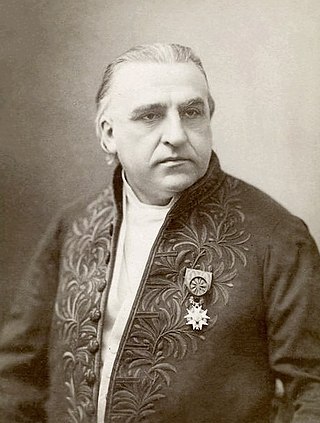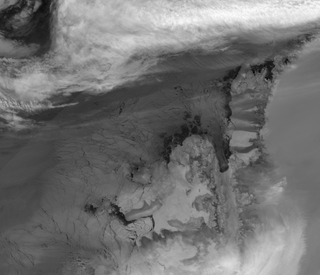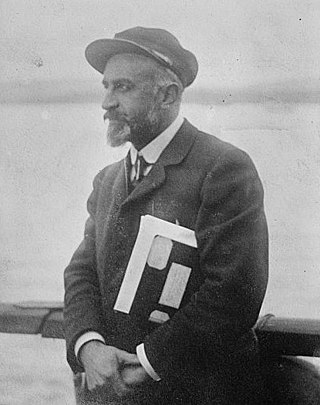
Charcot–Marie–Tooth disease (CMT) is a hereditary motor and sensory neuropathy of the peripheral nervous system characterized by progressive loss of muscle tissue and touch sensation across various parts of the body. This disease is the most commonly inherited neurological disorder, affecting about one in 2,500 people. It is named after those who classically described it: the Frenchman Jean-Martin Charcot (1825–1893), his pupil Pierre Marie (1853–1940), and the Briton Howard Henry Tooth (1856–1925).

Jean-Martin Charcot was a famous French neurologist and professor of anatomical pathology. He worked on groundbreaking work about hypnosis and hysteria, in particular with his hysteria patient Louise Augustine Gleizes. Charcot is known as "the founder of modern neurology", and his name has been associated with at least 15 medical eponyms, including various conditions sometimes referred to as Charcot diseases.

Booth Island is a rugged, Y-shaped island, 5 mi-long (8.0 km) and rising 980 m (3,215 ft) off the northwest coast of the Kyiv Peninsula in Graham Land, Antarctica, in the northeastern part of the Wilhelm Archipelago. The narrow passage between the island and the mainland is the Lemaire Channel.

Pitié-Salpêtrière University Hospital is a charitable hospital in the 13th arrondissement of Paris. It is part of the Assistance Publique – Hôpitaux de Paris and a teaching hospital of Sorbonne University.

Charcot Island or Charcot Land is an island administered under the Antarctic Treaty System, 56 kilometres (30 nmi) long and 46 kilometres (25 nmi) wide, which is ice covered except for prominent mountains overlooking the north coast. Charcot Island lies within the Bellingshausen Sea, 102 kilometres (55 nmi) west of Alexander Island, and about 57 kilometres (31 nmi) north of Latady Island. A notable landmark of the island is its northernmost point, Cape Byrd.

Jean-Baptiste-Étienne-Auguste Charcot, born in Neuilly-sur-Seine, was a French scientist, medical doctor and polar scientist. His father was the neurologist Jean-Martin Charcot (1825–1893).

Georges Albert Édouard Brutus Gilles de la Tourette was a French neurologist and the namesake of Tourette syndrome, a neurological condition characterized by tics. His main contributions in medicine were in the fields of hypnotism and hysteria.

The French Antarctic Expedition is any of several French expeditions in Antarctica.
Charcot disease can refer to several diseases named for Jean-Martin Charcot, such as:
Reynolds' pentad is a collection of signs and symptoms consistent with obstructive ascending cholangitis, a serious infection of the biliary tract. It is a combination of Charcot's triad with shock and an altered mental status. Sometimes the two additional signs are listed simply as low blood pressure and confusion.

Pierre Marie was a French neurologist and political journalist close to the SFIO.
Charcot–Bouchard aneurysms are aneurysms of the brain vasculature which occur in small blood vessels. Charcot–Bouchard aneurysms are most often located in the lenticulostriate vessels of the basal ganglia and are associated with chronic hypertension. Charcot–Bouchard aneurysms are a common cause of cerebral hemorrhage. Charcot–Bouchard aneurysm rupture might be linked to senile plaque formation in the Alzheimer's disease.

Pourquoi-Pas was the fourth ship built for Jean-Baptiste Charcot, which completed the second Charcot expedition of the Antarctic regions from 1908 to 1910. Charcot died aboard when the ship was wrecked on 16 September 1936, off the coast of Iceland. Of the forty men on board, only one survived.

The Syrezol Rocks are a small group of marine rocks lying 1 mile (1.6 km) west of Martins Head at the east side of the entrance to Admiralty Bay, near King George Island in the South Shetland Islands. In 1908–1910, the Fourth French Antarctic Expedition under Jean-Baptiste Charcot assigned the name "Cap Syrezol" to a feature between what is now Martins Head and Chabrier Rock. Since there is no distinctive point or cape in this position, the name has been applied to these rocks in order to preserve Charcot's naming in the area in which it was originally given.
Events from the year 1868 in France.

Charcot's cholangitis triad is the combination of jaundice; fever, usually with rigors; and right upper quadrant abdominal pain. It occurs as a result of ascending cholangitis. When the presentation also includes low blood pressure and mental status changes, it is known as Reynolds' pentad. It is named for Jean-Martin Charcot.

Augustine is a 2012 French historical erotic drama film written and directed by Alice Winocour, in her feature directorial debut. It follows a love affair between French neurologist Jean-Martin Charcot and his patient Louise Augustine Gleizes, who was known as Augustine or A. In reality, there was no sexual relationship between the two.

A Clinical Lesson at the Salpêtrière is an 1887 group tableau portrait painted by the history and genre artist André Brouillet (1857–1914). The painting, one of the best-known in the history of medicine, shows the neurologist Jean-Martin Charcot giving a clinical demonstration with patient Marie Wittman to a group of postgraduate students. Many of his students are identifiable; one is Georges Gilles de la Tourette, the physician who described Tourette syndrome.

Marie "Blanche" Wittman was a French woman known as one of the hysteria patients of Jean-Martin Charcot. She was institutionalized in La Salpêtrière in 1877, and was treated by Charcot until his death in 1893. She later became a radiology assistant at the hospital, which resulted in amputations of her arms due to radiation poisoning.














